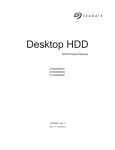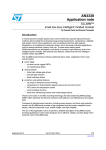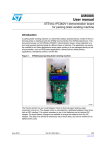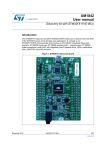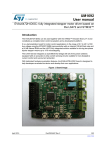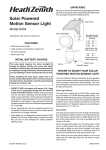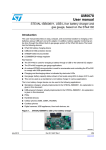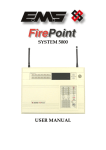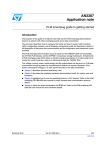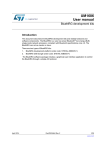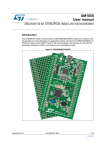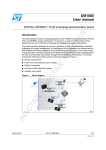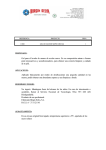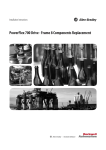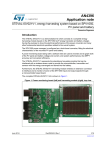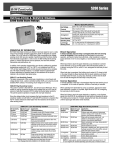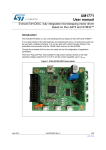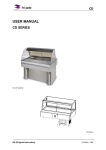Download UM1471 - STMicroelectronics
Transcript
UM1471 User manual 250 W DC-DC solar module for photovoltaic distributed architecture Introduction The STEVAL-ISV013V1 is a fully integrated module designed for a smart junction box in distributed photovoltaic architecture. The module represents an easy-to-use, fully-protected solution to implement precise photovoltaic panel control, diagnostic and protection. The STEVAL-ISV013V1 is the base element for a new photovoltaic panel configuration able to increase the panel energy produced and to simplify the photovoltaic field design and realization. Furthermore, the maintenance cost is reduced thanks to the possibility of monitoring the individual panel status and to communicate these data to a remote control unit. The demonstration board realizes an isolated converter to be connected at the output of a single PV panel for distributed MPPT. This voltage is stepped up to the voltage, defined by the inverter, needed to realize a sinusoidal output with a magnitude big enough to transfer energy in the grid. The module features an embedded MPPT (maximum power point tracking) algorithm based on the “Perturb and Observe” (P and O) technique to search for the best operating point of the panel in order to maximize the energy produced in every environmental condition. The module is internally protected against surge or lightning reaching the connection wires. The STEVAL-ISV013V1 can integrate a PLM or ZigBee® for communication. The PLM is supported by a proprietary protocol stack for networking. Gateway to RS485 in Modbus is available. The unit is designed to operate in a harsh environment offering a high level of protection and very high reliability. The ZigBee® module is based on system-on-chip (SoC) technology, integrating both IEEE 802.15.4 radio transceiver and computing capabilities and is designed to run a fully compliant ZigBee® PRO network protocol stack. Figure 1. July 2012 STEVAL-ISV013V1 image Doc ID 022251 Rev 1 1/15 www.st.com Contents UM1471 Contents 1 System description . . . . . . . . . . . . . . . . . . . . . . . . . . . . . . . . . . . . . . . . . . 4 2 Application circuit . . . . . . . . . . . . . . . . . . . . . . . . . . . . . . . . . . . . . . . . . . . 7 3 Electrical schematics . . . . . . . . . . . . . . . . . . . . . . . . . . . . . . . . . . . . . . . . 8 4 Digital control description . . . . . . . . . . . . . . . . . . . . . . . . . . . . . . . . . . . 12 5 Overcurrent and overvoltage protections . . . . . . . . . . . . . . . . . . . . . . . 13 6 Revision history . . . . . . . . . . . . . . . . . . . . . . . . . . . . . . . . . . . . . . . . . . . 14 2/15 Doc ID 022251 Rev 1 UM1471 List of figures List of figures Figure 1. Figure 2. Figure 3. Figure 4. Figure 5. Figure 6. Figure 7. Figure 8. STEVAL-ISV013V1 image . . . . . . . . . . . . . . . . . . . . . . . . . . . . . . . . . . . . . . . . . . . . . . . . . . 1 STEVAL-ISV013V1 image with highlighted hardware sections . . . . . . . . . . . . . . . . . . . . . . 4 STEVAL-ISV013V1 - I/O connectors . . . . . . . . . . . . . . . . . . . . . . . . . . . . . . . . . . . . . . . . . . 6 Typical application system . . . . . . . . . . . . . . . . . . . . . . . . . . . . . . . . . . . . . . . . . . . . . . . . . . 7 Electrical schematic - power board and aux. power supply . . . . . . . . . . . . . . . . . . . . . . . . . 9 Electrical schematic - sensing circuit and gate driver section. . . . . . . . . . . . . . . . . . . . . . . 10 Electrical schematic - microcontroller and level translator . . . . . . . . . . . . . . . . . . . . . . . . . 11 MPPT algorithm embedded on 32-bit microcontroller STM32 . . . . . . . . . . . . . . . . . . . . . . 12 Doc ID 022251 Rev 1 3/15 System description 1 UM1471 System description The STEVAL-ISV013V1 is a smart junction box for photovoltaic panels. It is a high efficiency isolated DC-DC boost converter operating in the input voltage range from 10 V to 45 V and able to step up the panel voltage to the input voltage of a DC-AC converter. In addition, it provides metering and monitoring features and implements some safety functions like fire and anti-theft protections. A general description of the system is shown in Figure 2, with an image highlighting the different hardware sections of the board. Figure 2. STEVAL-ISV013V1 image with highlighted hardware sections /UTPUT"US6OLTAGE POSITIVE RANGE66 06PANEL POSITIVE 6IN6 06PANEL NEGATIVE 6OUT 6 Ͳ !UXILI ARY03SECTION /UTPUT"US6OLTAGE NEGATIVE !-V It consists of several sections as listed below: ● DC-DC converter ● Auxiliary power supply ● Digital control section ● I/O connectors ● PLM - ZigBee external module connector. DC-DC converter section The power section, based on an isolated full bridge boost converter, is designed to accept low input voltage in the range 10-45 V. The output voltage is in the range 350-430 V, suitable to directly supply the DC bus of a standard single-phase inverter. The specifications in Table 1 for the PV system are used as inputs for the design of the DCDC converter. 4/15 Doc ID 022251 Rev 1 UM1471 System description Table 1. Main DC-DC converter specifications Symbol Parameter Value Unit Operating condition Vin Input DC supply voltage range 10 to 55 V Vin_MPPT MPPT input DC voltage range 24 to 45 V 350 to 430 V Vout Operating output DC voltage Iout Operating output current 0.8 A Fs Switching frequency 35 kHz Efficiency Peak eff. Peak efficiency 97.5% - Euro eff. European efficiency 96.6% - MPPT-eff. MPPT efficiency 99% - Auxiliary power supply section The auxiliary power supply has been developed to provide stable supply voltage for different electronic components, for example, gate-drivers, microcontroller, and operational amplifiers. In particular, the output voltages are the following: ● +15 V to supply MOSFET gate-driver, PLM module ● +5 V to supply level translator for gate driving ● +3.3 V to supply microcontroller, operational amplifiers, level translator, ZigBee module. This auxiliary power supply is developed to supply the module also from the output, implementing anti-theft during the night. Under this condition, the PLM unit and ZigBee unit are ON also under no solar irradiance condition. This feature is guaranteed by means of a supply voltage on the DC bus provided by an external power supply. Digital control section The digital control section is managed by STM32, a microcontroller central unit based on ARM Cortex™-M3 32-bit RISC core operating at a 72 MHz clock frequency. ● The key features are: – 1.25 DMIPS/MHz (Dhrystone 2.1) performance at 0 wait state memory access – Single-cycle multiplication and hardware division – 128 Kbytes of Flash memory, 20 Kbytes of SRAM – 12-bit, 1 µs A/D converter – DMA controller – 16-bit timers with IC/OC/PWM – SysTick timer 24-bit downcounter – USART communication interface. Doc ID 022251 Rev 1 5/15 System description UM1471 The STM32Fx controls the operation of the DC-DC converter with MPPT algorithm, monitors the input/output section with OVP and OCP, manages the synchronization with a cascaded inverter and the interface with external communication module (PLM-ZigBee). I/O connectors The STEVAL-ISV013V1 module is developed to be connected with photovoltaic panels (input side) and with inverters (output side). The areas 1 and 4, in Figure 3, are used to connect the demonstration board with a standard solar panel (with proper junction box). The areas 1-2-3-4 are used with a solar panel connected directly to this board. In this configuration, area 5 is for bypass diodes or SPV1001 cool bypass switch, an integrated smart diode by STMicroelectronics. Figure 3. STEVAL-ISV013V1 - I/O connectors 3OLARPANEL BUSBAROR*"CABLES /UTPUTCONNECTORS FORSOLARCABLES 0,-:IG"EE MODULECONNECTOR !-V PLM - ZigBee external module connector The STEVAL-ISV013V1 is ready to be connected to a PLM or ZigBee external module for communication. Figure 3 shows the communication board module connector. The power supply for this module is provided by the main board. 6/15 Doc ID 022251 Rev 1 UM1471 2 Application circuit Application circuit Figure 4 shows the typical photovoltaic system architecture which can be realized with the STEVAL-ISV013V1. It is worth noting that the distributed architecture is based on parallel connection of smart panels in a high voltage DC bus. Thanks to this approach, the DC-DC stage of the standard string inverter can be removed, reducing overall system complexity and cost. Figure 4. Typical application system Doc ID 022251 Rev 1 7/15 Electrical schematics 3 UM1471 Electrical schematics The power board schematic is shown in Figure 5. The input voltage, given by the PV panel in the range between 10 V and 55 V, is fed into the power circuit through the connector J1. The need for boosting the low input voltage to the much higher DC link voltage, required for interfacing with the inverter, is guaranteed by an isolated full bridge boost converter. The input boost inductor (L1), placed at the input side, permits low ripple current values, the output rectifying diodes (D1, D3) are placed across output capacitors, ensuring minimum voltage stress and effective voltage clamping. A high frequency transformer (TR1) is used to step up the input voltage and for functional isolation. The auxiliary power supply, based on an isolated Flyback converter, provides the supply voltage for the microcontroller, operational amplifiers, gate-drivers and level translator. The flyback transformer (TR2) has two secondary regulated outputs for +5 V and +15 V. An integrated voltage regulator (IC4) supplies the 3.3 V from 5 V. Figure 6 shows the section for I/O sensing, in particular the panel output voltage and current are measured for maximum power point tracking algorithm. The output bus voltage is controlled for overvoltage protection (OVP) and to establish the communication with the cascaded inverter. 8/15 Doc ID 022251 Rev 1 Doc ID 022251 Rev 1 - ' " & *1' . 5 & 10 / / 10 [" ' 76 & " 5 . 5 . & S 5 . 5 . 9 & " & Q & S *1' ,&$ 76 & Q 5 . & " 9)% & Q 8& % 57&7 ,6(16( 5 . 4 %& *1' 287 9, 95() 5 . +3$. 4 67+1) 5 . 5 RKP " 5 . 5 RKP ' %$7 62' ' %$7 4 %& 1060$ & ' & " 5 . 5 . ' 5 0 5 10 5 . . 5 ,& 76 5 . 5 0 5 . 5 0 +3$. & & Q '3$. 5 . 5 . 4 67'1) 677+5$ ' ' 60$- 62' ' 1 9 4 %& 6285&( " 75 4 67+1) +3$. 4 67+1) 9287 5 0 9ROWDJHPD[9 5 0 76 5 RKP & 4 00%7$ " & 5 0 9,1387 ',$0H & X 9 " 6285&( *1' & Q ,& 76 5 . & Q 2XW *$7( ' 60%-&$ 4 67+1) 60% *$7( +3$. 9ROWDJHPD[9 ,&$ 76 0 5 & " ,B6(16B39 ' 1 5 . &203 ,& 5 . . 5 . 5 . 2XW *$7( 0 5 5 0 4 & S 9 & / X+ $ *$7( X9 00%7$ 5 9 & 10 & *1' X 5 . Q & 10 60$60% ' 60$ [ & Q 671+1 . 10 ' 5 0 4 5 0 P2KP 5 60% ' 10 9ROWDJHPD[9 5 . 9,1387 ,B6(16B39 5 . 9,1B6(16B39 P+ ',$0H *1' *1' 5 . & Q & X 9 5 . 5 RKP 5 10 5 10 60% ' 677+/8 639' 9,1387 639' ' ' 639' -63$5( -63$5( )SOLATEDFULLBRIDGE BOOSTCONVERTER - RKP 5 5 RKP '3$. 75 & 75 ' Q9 & [ / X+ 60$ & X 9 5 RKP 9 & X VRW ,1387 287387 *1' & 5 10 -3 *1' 62' ' 9 & X 9 -3 9 ' 10 5 . 9287B(;7 X9 [ S 9EXVB6(16 [ X+ / 5 . 5 0 5 0 10 / ,& /'$%875 5 . 5 RKP 9 & S 6736+ 60%60$ 6736/ ' X9 & X9 5 RKP 9 & S ' 677+5* 9ROWDJHPD[9WR*1' '3$. ' 677+5* *1' *1' 9 9 9&& 9287 - &21 9 & X Figure 5. RKP 5 )86( ) 9287 UM1471 Electrical schematics Electrical schematic - power board and aux. power supply !UXILIARYPOWERSUPPLY !-V 9/15 9&& Doc ID 022251 Rev 1 5 10 & 10 $'&B3$1(/B92/7$*( 3:0B9 3:0B9 . 5 & Q . 6285&( /9* 287 +9* 9ERRW 677+$ /( *1' 9FF +,1 /,1 ,& ' /9* 287 +9* 9ERRW 6285&( /( *1' 9FF +,1 /,1 677+$ 60$ & X) & X) ' ' ' ' ' ' ' ' ,Q ,Q 287 9FF 9 769%,' 9FF ,Q ,Q 287 ,& . 5 5 10 & Q Q & 10 & 5 . 5 . 5 5 9,1B6(16B39 . & 10 RKP 5 RKP RKP 5 RKP 5 5 RKP RKP 5 5 RKP RKP 5 $IODES3403! 2ESISTORSSIZE 066/,4!'% 3%.3).'3%#4)/. & Q . 5 . 5 5 ,& ' *DWH 2XW *DWH *DWH 2XW *DWH ,B6(16B39 ,B6(16B39 5 6 6 -3 9 5 . 6(/ ' 5 10 10 5 769%,' 9FF ,Q ,Q 287 5 . 5(6(7 7567 7', 7'26:2 7&.6:&/. & 10 5 . 5 . & 10 5 . 7066:', 2 & Q) 3% 6,*1$/B,39 & Q & 10 ,& . 5 ,Q ,Q 287 9FF 9 6"533%.3).' . 5 10 & 10 & Q & Q) & ,& ,1 9 5 . & . 5 5 . 5 . Q) & 5 . 5 10 9 $'&B3$1(/B&8 55(17 $'& B%86B92/7$*( 287 9 10 76,'7 ,1 &21 - 5 . 5 . 06#522%.43%.3).'3%#4)/. . ,& 67*'75 9 9EXVB6(16 . 5 9&& *1' 9 10/15 9 Figure 6. $#$#$RIVERSECTION Electrical schematics UM1471 Electrical schematic - sensing circuit and gate driver section !-V *1' / Doc ID 022251 Rev 1 )5(4 6: 2KP 5 *1' & Q '2:1 5 2KP 3%7,0B&+ 5 2KP 3% 5 . 3:0 3$ *1' S & 3% 6: 2KP 5 9 *1' & Q 83 5 . 6: 2KP 5 9 *1' 9 *1' & Q 5 . *1' . 5 . 5 3% 3% $549#9#,%"544/.3/.,9&/2$%"5' 3$ 3$ 3$ 5 2KP 3$ S 3$ S 3$ & 3% & *1' 3$ 3$ 3$ 3% *1' *1' & X9 3% 9 3$ 3$ 966B $'&B3$1(/B&855(17 $'&B3$1(/B92/7$*( $'&B%86B92/7$*( & Q Q & 3% 3% 3% 3% 3$ 3$ 3$ 3$ 3$ 3$ 966B 9''B 9'' B %/03*61/ '2:1 3$:.83 9''$ 966$ 1567 3'26&B287 3'26&B,1 3&26&B287 3&26&B,1 3$ 3$7,0B&+ 9'' B -803(5)250337(1$%/( %227 -3 )5(4 *1' 9 3% 3:0 3:0 9 &21$ - *1' & S *1' *1' 67 1567 N 5 1& 1& ,29/ , 29&& ,29/ , 29&& *1' 5 N ,& 9&& 9/ *1' & Q 5 N 9 9 -352/81*$ #/..%44/2)342)0,).% 3$7,0B&+ 3%7,0B&+ 5(6(7 . 5 5(6(7&,5&8,7 7066:',2 *1' $%"5'#/.. %#4/2 -3 9 3% 3% 3% 3% 3$ 3$ 3$ 3$ 3$ 3$-7$* 3:0 3:0 $'&B3$1(/B&85 5(17 $'&B3$1(/B92/7$*( $'&B%86B92/7$*( 6,*1$/B,39 3% 3$ 3$ 9 *1' & Q 9 2( 9 3:0 966 B *1' 3% 670)&%7 ,1&0 3% %2 27 83 1567 3% 2KP S 3% & 3% 5 3% 6,*1 $/B,39 < 0K] 3% 75 67 3&7$03(5B57& 7' 26: 2 3% 3$ 9%$7 S & 3$ - 7 $* *1' *1' 2KP 5 ,& *1' 3$ - 7 $* *1 ' &2%15%.#9"544/.3/.,9&/2$%"5' & S < .K] Q & 3% 3% ) 5 (4 5 2KP 9 7', . 5 7& .6: & /. & S 9 *1' 9 & Q 3&%$ *1' & Q 5(6(7 675,33,1 6: 3:0B9 3:0B9 - &21 *1' & S 9&& *1' 3$ 3$ 9 9 *1' *1' & S 3$ 3$ 23 576B &76B 7;'B 5;'B *1' & S 0,-:)'"% %#/..%#4 /2 0#O R0# *1' & S 3% 3% 3% 3% 3% 3% 3% 3% 3$ 9287B(;7 9287 *1' & S 9 Figure 7. *1' %227 -3 UM1471 Electrical schematics Electrical schematic - microcontroller and level translator !-V 11/15 Digital control description 4 UM1471 Digital control description The overall control architecture requires three feedback signals for correct operation, input panel current and input panel voltage are used for maximum power point tracking; the output bus voltage is used for monitoring OV condition and to control the starting/stopping procedure. These signals are sent to the ADC inputs of the microcontroller, according to the pin assignment of Figure 7, and in function of these values, two timers generate PWM output to drive the full bridge power MOSFETs or disable the driving signals to turn off the module, isolating the solar panel from the output bus. The duty cycle value is regulated by a maximum power point tracking algorithm implemented by the STM32 microcontroller (Figure 8). Figure 8. MPPT algorithm embedded on 32-bit microcontroller STM32 $#$# #ONVERTER ( $# /UTPUT 2ESISTORDIVIDER FOR!$# SENSING $#$UTYCYCLEVALUE #$UTYCYCLESTEPVALUE 6K)NPUT VOLTAGE 0K0OWER 6 0 6 $# 6SENSE ( ( 3ENSE6K)K )SENS 0K6K )K 34- -ICROCONTROLLER !$ CONVERTER .EW$UTYCYCLE VA LUECALCULATED 0REVIOUS 0OWERAND)NPUT 6OLTAGEVA LUE REGISTER -004 #ONTROLLER .O 6K6+ 6K6+ .O $#$# # 9ES 0K0K 9ES $#$## .O $#$# # 9ES $#$## !-V 12/15 Doc ID 022251 Rev 1 UM1471 5 Overcurrent and overvoltage protections Overcurrent and overvoltage protections The overcurrent and overvoltage protections have been implemented in order to avoid damaging the hardware. The short-circuit and the open circuit condition at the output connectors (Vout+, Vout-) of the junction box forces the microcontroller to isolate the solar panel from the output. At the changed condition, the system restarts following the start-up procedure. The output voltage is limited via firmware at 430 V. Doc ID 022251 Rev 1 13/15 Revision history 6 UM1471 Revision history Table 2. 14/15 Document revision history Date Revision 27-Jul-2012 1 Changes Initial release. Doc ID 022251 Rev 1 UM1471 Please Read Carefully: Information in this document is provided solely in connection with ST products. STMicroelectronics NV and its subsidiaries (“ST”) reserve the right to make changes, corrections, modifications or improvements, to this document, and the products and services described herein at any time, without notice. All ST products are sold pursuant to ST’s terms and conditions of sale. Purchasers are solely responsible for the choice, selection and use of the ST products and services described herein, and ST assumes no liability whatsoever relating to the choice, selection or use of the ST products and services described herein. No license, express or implied, by estoppel or otherwise, to any intellectual property rights is granted under this document. If any part of this document refers to any third party products or services it shall not be deemed a license grant by ST for the use of such third party products or services, or any intellectual property contained therein or considered as a warranty covering the use in any manner whatsoever of such third party products or services or any intellectual property contained therein. UNLESS OTHERWISE SET FORTH IN ST’S TERMS AND CONDITIONS OF SALE ST DISCLAIMS ANY EXPRESS OR IMPLIED WARRANTY WITH RESPECT TO THE USE AND/OR SALE OF ST PRODUCTS INCLUDING WITHOUT LIMITATION IMPLIED WARRANTIES OF MERCHANTABILITY, FITNESS FOR A PARTICULAR PURPOSE (AND THEIR EQUIVALENTS UNDER THE LAWS OF ANY JURISDICTION), OR INFRINGEMENT OF ANY PATENT, COPYRIGHT OR OTHER INTELLECTUAL PROPERTY RIGHT. UNLESS EXPRESSLY APPROVED IN WRITING BY TWO AUTHORIZED ST REPRESENTATIVES, ST PRODUCTS ARE NOT RECOMMENDED, AUTHORIZED OR WARRANTED FOR USE IN MILITARY, AIR CRAFT, SPACE, LIFE SAVING, OR LIFE SUSTAINING APPLICATIONS, NOR IN PRODUCTS OR SYSTEMS WHERE FAILURE OR MALFUNCTION MAY RESULT IN PERSONAL INJURY, DEATH, OR SEVERE PROPERTY OR ENVIRONMENTAL DAMAGE. ST PRODUCTS WHICH ARE NOT SPECIFIED AS "AUTOMOTIVE GRADE" MAY ONLY BE USED IN AUTOMOTIVE APPLICATIONS AT USER’S OWN RISK. Resale of ST products with provisions different from the statements and/or technical features set forth in this document shall immediately void any warranty granted by ST for the ST product or service described herein and shall not create or extend in any manner whatsoever, any liability of ST. ST and the ST logo are trademarks or registered trademarks of ST in various countries. Information in this document supersedes and replaces all information previously supplied. The ST logo is a registered trademark of STMicroelectronics. All other names are the property of their respective owners. © 2012 STMicroelectronics - All rights reserved STMicroelectronics group of companies Australia - Belgium - Brazil - Canada - China - Czech Republic - Finland - France - Germany - Hong Kong - India - Israel - Italy - Japan Malaysia - Malta - Morocco - Philippines - Singapore - Spain - Sweden - Switzerland - United Kingdom - United States of America www.st.com Doc ID 022251 Rev 1 15/15















